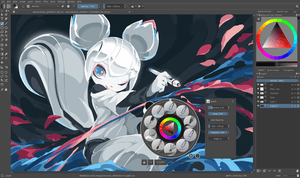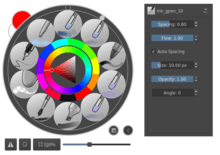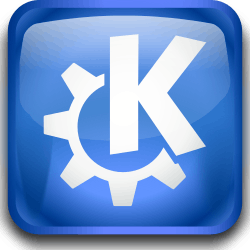Krita
|
| |
 | |
| Developer(s) | KDE |
|---|---|
| Initial release | 21 June 2005 |
| Stable release | 4.1.5 (11 October 2018[1]) [±] |
| Preview release | 4.2 preview (4 October 2018[2]) [±] |
| Repository | git repo on KDE |
| Written in | C++, Qt |
| Operating system | Unix-like, Windows,[3] macOS[3] |
| Type | Raster graphics editor |
| License | GPLv3 only[4] |
| Website |
krita |
Krita is a free-software and an open-source raster graphics editor, designed primarily for digital painting and animation purposes. It features a low-distract UI, high-quality OpenGL accelerated canvas, color management support, advanced brush engine, non-destructive layers and masks, group-based layer management, vector artwork support and switchable customization profiles. It runs on Linux, Microsoft Windows, and macOS.
Name
The project's current name "Krita" has multi-cultural references. In Swedish, krita means "crayon" and rita means "to draw". In the ancient Indian epic Mahabharata, the name "krita" is used in a context where it can be translated into "perfect".[5]
History
Early development of the project can be tracked back to 1998 when Matthias Ettrich, founder of KDE showcased a Qt GUI hack for GIMP on Linux Kongress. The idea of building a Qt-based image editor was later passed to KImage, maintained by Michael Koch, as a part of KOffice suite. In 1999, Matthias Elter proposed the idea of building the software using Corba around ImageMagick. To avoid existing trademarks on the market, the project underwent numerous name changes: KImageShop, Krayon, until it was finally settled with "Krita" in 2002. The first public version of Krita was released with KOffice 1.4 in 2004.[6] In years between 2004 and 2009, Krita had been developed as a generic image manipulation software like Photoshop and GIMP.
Change of direction happened to the project in 2009, with a new goal of becoming a digital painting software like Corel Painter and SAI. Also from that point, the project began to experiment with various ways of funding its development, including Google Summer of Code and funded jobs for students. As a result, the development gained speed and resulted in better performance and stability.[7]

The Krita Foundation was created in 2013 to provide support for Krita's development. It collaborated with Intel to create Krita Sketch as a marketing campaign and Krita Studio with KO GmbH as commercially supported version for movie and VFX studios. Kickstarter campaigns have been used to crowdfund Krita's development since 2014.
| Time | Version | Raised | Kickstarter Campaign | Stable release |
|---|---|---|---|---|
| July 2014 | 2.9.x | €19,955 | Faster Development, better PSD support, layers, masks, brush, resource manager, display, etc.[8] | February 2015 |
| May 2015 | 3.0.x | €30,520 | Better performance, animation support, layer, workflow, transform, filter, brush, etc.[9] | May 2016 |
| May 2016 | 4.0.x | €38,579 | Better text tools and vector art capability, python scripting support, etc.[10] | March 2018 [11] |

Design and features
The current version of Krita is developed with Qt 5 and KDE Frameworks 5. It is designed primarily for concept artists, illustrators, matte and texture artists, and the VFX industry. It has the following key features:[12]
User experience design

The most prominent feature of Krita is arguably its UX design with graphics tablet users in mind. It uses a combination of pen buttons, keyboard modifiers and an icon-based HUD to ensure frequently-used functions can be accessed by fewer clicks, without the need to search through text-based menus.
Most-used drawing commands can be blindly accessed by a few combinations of 2 keyboard modifiers with 2 pen/mouse buttons:
| Command | Input |
|---|---|
| Brush size +/- | Shift + Pen drag |
| Pick color | Ctrl + Pen tap |
| Pan | Pen button + Pen move |
| Zoom | Ctrl + Pen button + Pen move |
| Rotate | Shift + Pen button + Pen move |
Pop-up Palette is Krita's right click HUD. It enables instant access to the following functions:
| Brush | Color | View |
|---|---|---|
| 10 loaded brush presets | Color ring selector | Zoom |
| Load other preset groups | FG/BG color display | Rotate |
| Brush size, opacity, flow, spacing, angle | Recent color | Mirror |
| Canvas-only | ||
| Reset view |

Painting tools
Krita's core digital painting tools includes:
| Brush | Drawing assistants | Selection tools | Transformation tools |
|---|---|---|---|
| Graphics tablet support | Adjustable interference intensity | Rectangle | Free position |
| 9 different brush engines | Infinite and parallel straight rulers | Ellipse | Rotate |
| Modelled after real tools | Splines (curves) | Freehand (lasso) | Scale |
| Highly adjustable | Ellipses | Polygon | Shear |
| Remembers settings for each physical pen | Perspective | Outline | Perspective |
| Pen stabilizer | Vanishing point | Fill | Wrap |
| Multibrush painting support | Fish-eye point | Color | Cage |
| Opacity | Liquify |

Animation tools
Krita's animation tools is designed for frame-by-frame raster animation. It has the following features:
| Interface | Import | Export |
|---|---|---|
| Similar interface of Adobe Flash | Batch import of frames | Render with ffmpeg |
| Timeline controls | Output to individual frames | |
| Realtime animation playback controls | Output to GIF, AVI, MP4, etc. | |
| Onion-skin display |

Vector tools
Krita uses vector tools for non-destructive editing of the following objects:
- Path
- Selection
- Text (artistic, multiline, calligraphy)
- Vector art
- Fill and gradient

Layers and masks
Krita's layer and mask features includes:
| Layer management | Mask applies to | Non-destructive layers | Non-destructive masks |
|---|---|---|---|
| Multiple level layer groups | Raster layers | Clone layers | Transparency masks |
| Select multiple layers | Vector layers | Filter layers | Filter masks |
| Drag-and-drop layers | Layer groups | Fill layers | Colorize masks |
| Layer highlighting | Non-destructive layers | File layers | Transform masks |
| Local selection masks |
Customization

Krita's resource manager allows each brush or texture preset to be tagged by user and quickly searched, filtered and loaded as a group. A collection of user-made presets can be packaged as "bundles" and loaded as a whole. Krita provides many of such brush set and texture bundles on its official website.
Customizable tool panels are known as Dockers in Krita. Actions include:
- 2 customizable toolbars
- Toggle display of each docker
- Attach any docker to any sides of main window, or detach to float free
- Buttons to collapse/expand each docker panel
- Group dockers by tabs
Workspace profiles allow different UI customizations to be saved for different workflows being loaded instantly.

Display
OpenGL accelerated canvas is used to speedup Krita's performance. It has the following benefits:
- Better-framerate and response time, pen actions can be reflected without delay
- Better-quality, fast and continuous zooming, panning, rotation, wrap-around and mirroring
- Requires a GPU with OpenGL 3.0 support for optimal experience, in case of Intel HD Graphics, it means Ivy Bridge and above.

Full color management is supported in Krita with the following capabilities:
- Assign and convert between color spaces
- Realtime color proofing, including color-blind mode
- Color model supported: RGBA, Gray, CMYKA, Law, YCbCr, XYZ
- Color depth supported: 8-bit integer, 16-bit integer, 16-bit floating point, 32-bit floating point
Filters

Krita has a collection of built-in filters and supports G'MIC filters. It has realtime filter preview support.
Filters included in a default installation: levels, color adjustment curves, brightness/contrast curve, desaturate, invert, auto contrast, HSV adjustment, pixelize, raindrops, oil paint, gaussian blur, motion blur, blur, lens blur, color to alpha, color transfer, minimize channel, maximize channel, top/left/bottom/right edge detection, sobel, sharpen, mean removal, unsharp mask, gaussian noise removal, wavelet noise reducer, emboss horizontal only/in all directions/(laplacian)/vertical only/with variable depth/horizontal and vertical, small tiles, round corners, phong bumpmap.
File formats supported
Krita's native document format is Krita Document (.kra). It can also save to many other file formats including PSD.
| File formats | |
|---|---|
| Save to | Krita Document, OpenRaster document, PSD image, PPM, PGM, PBM, PNG, JPEG-2000, JPEG, BMP Windows, XBM, TIFF, EXR, PDF, WebP |
| Import only | Krita Document, EXR, OpenRaster document, PSD image, Gimp image, PPM, PGM, PBM, PNG, JPEG-2000, PDF, ODG draw, BMP Windows, XPM, GIF, XBM, Krita Flipbook, Adobe DNG and Camera RAW, WEBP |
| Export only | / |
Mascot

Krita's mascot is Kiki the Cyber Squirrel, a robotic, anthropomorphic squirrel character created by Tyson Tan. The community collectively decided the mascot to be a squirrel because "krita" is also the Albanian word for Squirrel. The first version of Kiki was posted to KDE forum in 2012 and it was used in Krita version 2.6's introduction booklet.[13] Kiki has been used as Krita's startup splash since Krita version 2.8.[14][15] So far, each new version of Krita came with a new version of Kiki. Kiki has been used for Krita's merchandise shop items[16] and Krita's Steam project artworks.[17][18]
Sprint events
Krita sprints are events that Krita developers get together for a few days, exchange ideas and do programming face-to-face, in order to speedup development and improve relationships between members.
| Year | Date | Place |
|---|---|---|
| 2005[19] | / | Deventer, Netherlands |
| 2010[20] | 02-26 to 03-07 | Deventer, Netherlands |
| 2011[21] | 05-20 to 05-22 | Amsterdam, Netherlands |
| 2014[22] | 05-16 to 05-18 | Deventer, Netherlands |
| 2016[23] | 01-23 to 01-24 | Deventer, Netherlands |
| 2016[24] | 08-26 to 08-28 | Deventer, Netherlands |
Variations
See also
- Comparison of raster graphics editors
- GIMP
- MyPaint
- List of computing mascots
- Category:Computing mascots
References
- ↑ "Krita 4.1.5 Released | Krita".
- ↑ "Looking forward to Krita 4.2!".
- 1 2 "Krita Desktop | Krita". Krita Foundation. Retrieved 2016-05-30.
- ↑ "KDE/krita". GitHub.
- ↑ "KritaFAQ - Krita Documentation". docs.krita.org. Retrieved 2017-07-22.
- ↑ Foundation, Krita. "History | Krita". krita.org. Retrieved 2017-07-22.
- ↑ Foundation, Krita. "History | Krita". krita.org. Retrieved 2017-07-22.
- ↑ "Krita: open source digital painting - Accelerate Development".
- ↑ "Krita: free paint app - let's make it faster than Photoshop!".
- ↑ "Krita 2016: Let's Make Text and Vector Art Awesome!".
- ↑ https://www.phoronix.com/scan.php?page=news_item&px=Krita-4.0-Released
- ↑ Foundation, Krita. "Highlights | Krita". krita.org. Retrieved 2017-07-22.
- ↑ "About Krita 2.6 Booklet" (PDF). Krita Foundation. Archived from the original on 2013-04-25.
- ↑ "Calling for Splashes!". Retrieved 22 February 2014.
- ↑ "Krita's Git commit of Krita 2.8's splash".
- ↑ Far, Maria. "Awesome designs by Tyson Tan!". Krita Foundation. Archived from the original on 26 February 2014. Retrieved 22 February 2014.
- ↑ "Krita's Steam page". Retrieved 22 February 2014.
- ↑ Tan, Tyson. "Krita the Digital Painting App is now on Steam". Retrieved 22 February 2014.
- ↑ Boudewijn Rempt (2005-07-30). "And on the fifth day..." valdyas. valdyas.org. Archived from the original on 2011-07-25. Retrieved 2011-06-20.
- ↑ Boudewijn Rempt (2010-03-15). "Second Krita Sprint Ends With Tea". KDE. KDE.NEWS.
- ↑ Boudewijn Rempt (2011-06-02). "What happens When Artists and Developers Come Together: The 2011 Krita Sprint". KDE. KDE.NEWS.
- ↑ "2014 Krita Sprint in Deventer, Netherlands". KDE.news. 2014-06-04. Retrieved 2016-07-16.
- ↑ Foundation, Krita. "Kicking off 2016 — the first Krita Sprint | Krita". krita.org. Retrieved 2017-07-23.
- ↑ Foundation, Krita. "2016 Krita Sprint: Day 1 | Krita". krita.org. Retrieved 2017-07-23.
- ↑ Foundation, Krita. "Krita Gemini | Krita". krita.org. Retrieved 2017-07-23.
- ↑ Foundation, Krita. "Krita Studio | Krita". krita.org (in French). Retrieved 2017-07-23.
External links
| Wikimedia Commons has media related to Krita. |
